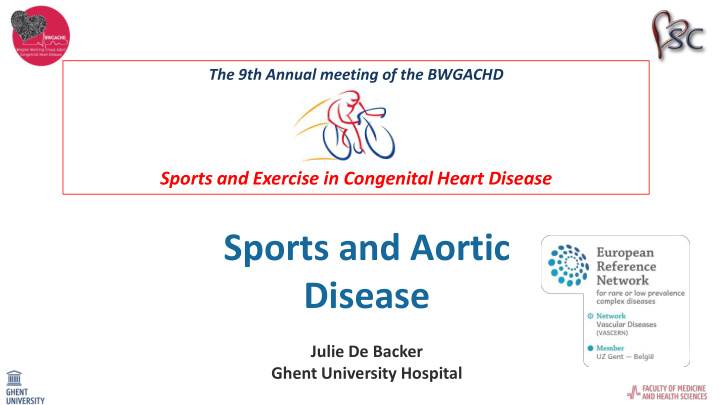



The 9th Annual meeting of the BWGACHD Sports and Exercise in Congenital Heart Disease Sports and Aortic Disease Julie De Backer Ghent University Hospital
Why? Flo Hyman (1954 -1986) • Avoid SCD Captain of the American Women ’ s Olympic • Volleyball team • Died during a match in Japan at age 32 > Acute aortic dissection Post mortem diagnosis of MFS • • Avoid accelerated progression of cardiovascular disease
Who? • Athletes • Leisure/recreational sport activities
What? Benjamin D. Levine et al. Circulation. 2015;132:e262-e266
How does it happen? P RESSURE RISE • Laplace’s Law: • Aerobic/dynamic exercise produces only a modest rise in arterial blood pressure (140-160 mmHg) except at the highest levels of exertion, at which pressures between 180-220 mmHg are reached. • Static/Weight lifting: pressure rise up to 300mmHg • In a dilated vessel: T
What do we know • Aortic dissection: 1.6% of SCD in athletes • Aortic diameter in 31 weight lifters with dissection: 4.6cm • Aortic root dilatation in athletes • Meta analysis in 5580 athletes: aortic root diameter +3.2mm vs controls “We cannot exclude the possibility that some of the increase in aortic-root size may be due to the larger body size of athletes, and that exercise training has no effect” • Large increases in aortic size over time are unusual in athletes and when present are more consistent with an underlying pathological aortopathy, which may be exacerbated by exercise training • Aortic dilatation more common in tall athletes in a Japanese screening study in 1922 athletes (x10 in Volleyball and Basketball – 2 Marfan) Maron, B.J. et al., 2014. Journal of the American College of Cardiology, 63(16), pp.1636 – 1643. Iskandar, A. & Thompson, P.D., 2013.. Circulation, 127(7), pp.791 – 798. Kinoshita, N. et al., 2000. American heart journal, 139(4), pp.723 – 728. Hatzaras, I. et al., 2007. Cardiology, 107(2), pp.103 – 106.
What we do not know (and probably will never know …) • Proportion of athletes with genetic disease • No outcome studies! • Effect of training in Marfan patients • Effect of medical treatment on risk for dissection during exercise • Proportion of AD in MFS related to exercise • Risk after surgery
What can we do? • Measure aortic diameters! • CPET: Measure HR & blood pressure response – titrate level of safe physical activity B blockers!
Leisure/Recreational sport
Leisure/Recreational Sport 0 😡 5 😋 1 ☹ 2 3 4 Body Building Rock Climbing Basketball Tennis (Single) Tennis (Double) Bowling Weight Lifting (Wind)surfing Baseball Biking Treadmill Bicycle Golf (Scuba) Diving Ice Hockey Skiing Jogging Skating Soccer Swimming Snorkling Motor Cycling Brisk walking Sprinting Maron 2004
No/Mild Dilatation ≤30mm - 35mm) Moderate Dilatation ≥35 - <45mm Severe Dilatation ≥45 - <50mm Dilatation approaching indication for repair ≥50mm
Swiss Jumping E-Fitness Bikram Yoga
Athletes
Athletes • Athletes with Marfan syndrome should undergo echocardiographic (and in some instances MRA or CT) measurement of the aortic root dimension every 6 to 12 months, depending on aortic size (Class I; Level of Evidence C) . • It is reasonable for athletes with Marfan syndrome to participate in low and moderate static/low dynamic competitive sports if they do not have ≥1 of the following (Class IIa; Level of Evidence C) : • Aortic root dilatation (ie, z score > 2, or aortic diameter >40 mm, or >2 standard deviations from the mean relative to BSA in children or adolescents <15 years old • Moderate to severe mitral regurgitation • Left ventricular systolic dysfunction (ejection fraction <40%) • Family history of aortic dissection at an aortic diameter <50 mm
Athletes • It is reasonable for athletes with surgical correction of the aortic root or ascending aorta for aneurysm disease or dissection and no evidence of residual aortic enlargement or dissection to participate in low static, low dynamic sports (class IA) that do not include the potential for bodily collision (Class IIa; Level of evidence C) . • Athletes with Marfan syndrome, familial TAA syndrome, Loeys-Dietz syndrome, unexplained aortic aneurysm, vascular Ehlers-Danlos syndrome, or a related aortic aneurysm disorder should not participate in any competitive sports that involve intense physical exertion or the potential for bodily collision (Class III; Level of Evidence C) . • Athletes with chronic aortic dissection or branch vessel arterial aneurysm or dissection should not participate in any competitive sports (Class III; Level of Evidence C) .
Conclusions • Encourage physical activity! • Guidelines are scarce/not always clearly delineated • No outcome data • Isometric exercise, collision/contact sports, and competitive, moderately dynamic activities should be avoided • Low weight (< 50 pounds) isometric activities might be acceptable, with avoidance of straining and the Valsalva • Individualized approach! • Aortic diameter! • CPET
Recommend
More recommend